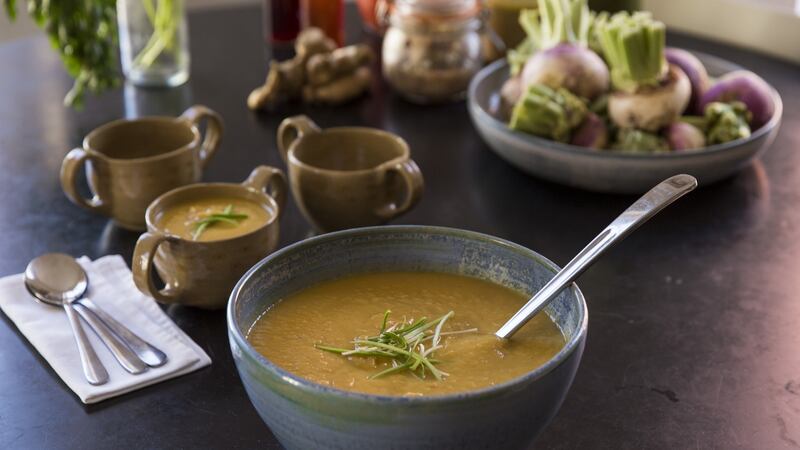
There’s something about this time of year that nudges us towards getting our house in order. We’re now in the middle of November and witness to the Christmas preamble. It’s a good time to start making a bit of space for the busy few months ahead.
Over the years, I have found it best to start in my kitchen, as it’s the hub of any home. It’s always open, in demand and mostly where we socialise. My aim every year is to create more free worktop space with less clutter to give me a sense of freedom.
Make a plan by starting with your fridge and seeing what needs to be used up, there’s nearly always the making of a soup in the bottom drawer. Get your soup bubbling away while you work your way through your cupboards or shelves. You will be amazed what you will achieve in such little time.
As you work through your dried goods, check the use by dates but also taste as you go. When items are stored well there is a chance that they can be saved by toasting, poaching or, sometimes, just using sooner rather than later. I find with some foods, use by dates are a guideline more than a hard and fast rule. Simple adaptations of store cupboard ingredients can make a extraordinary addition to meals. Nuts and seeds oiled and mixed with a little spice, sweetener and salt can end up being a real treat to go with a salad.
Ultimately, an ordered kitchen makes cooking more relaxing and enjoyable which gives you the ability to be more creative and efficient in the kitchen.
Leeks Vinaigrette
This is a classic and I’ve been cooking it for years. Every time I do, I’m surprised by how so few ingredients can give such an amazing result.
Most recipes for this dish use small whole leeks, but we’re not always lucky enough to find them. It is so important to wash the leeks very well, otherwise, you will find soil where you wouldn’t expect. Leeks cook quickly. This is a cold dish so remove them from the boiling water when they still have a bite to them or they’ll get overcooked very quickly and will, in fact, continue to cook as they cool. This makes a great starter but doubling the quantities makes it work really well as a light lunch with a good loaf of bread or served alongside some cold roast beef or ham.

Serves 4
Ingredients
4 medium leeks, chopped into rings and washed
2 hard boiled eggs
chives or parsley
Dressing
2 tbsp smooth dijon mustard
2 tbsp cider vinegar
2 to 4 tbsp water
300-450 ml olive oil
Method:
1. Leeks are tricky to get clean so fill the sink, a basin or a bowl with water, add the chopped leeks and give them a good stir to help loosen the dirt. Let them sit for a while and let the soil settle to the bottom.
2. Cook the leeks in boiling water until tender, this happens very fast so don’t wander too far! Drain and allow to cool.
3. Make the dressing by putting the mustard, vinegar and 2 tbsp water in a blender. While the motor is running add the oil slowly. If the dressing is too thick let it down with water. You are looking for a pouring dressing.
4. Arrange the leeks in a dish and pour over the dressing, grate over the hard boiled eggs and sprinkle with the herbs
Tips: Vegans can just drop the eggs, it’s still a great dish.
For those who do like eggs but not the look of them hard boiled, add the eggs to the dressing ingredients in the blender and whizz up
Turnip and Ginger Soup
Vegetable soup is a wonderful basic to have in your repertoire. It’s delightfully simple in that you can make a vegetable soup without a stock of any form.
The secret is good vegetables, proper seasoning at the beginning of the cooking process and plenty of time. Turnip, which so often gets forgotten about at the bottom of the fridge, is a lovely vegetable and goes so well with ginger in this soup. If you have some turnip left over, chop it up and roast it to go with your Sunday roast beef. (You can always replace the turnip for any other starchy vegetable such as parsnips, potatoes, squash or pumpkin or a mixture of any of these.)

Serves 4
Ingredients
Olive oil
2 medium onions, roughly chopped
3 sticks celery, roughly chopped
1 large carrot, roughly chopped
A good thumb, size root ginger
Salt and pepper
1 - 1 1/2 litres tap water
400g turnip, peeled and chopped
Method:
1. Warm a heavy based large saucepan, add a good splash of oil followed by the onions, celery, carrot, grated ginger and a good pinch of salt and pepper. Mix well.
2. Cook the vegetables for a least 5 minutes or until they are starting to soften, on a medium to low heat, mixing now and again.
3. Turn the heat to the lowest (use a heat diffuser if you have one) and put on a tight fitting lid and cook for at least 20 minutes, the longer and slower you do this the better the flavour.
4. Add the water and the turnip, bring to the boil and simmer for 20 minutes or until the turnip is very soft.
5. Taste and add more seasoning if needed. If it looks too thick add some more water and bring back to the boil and simmer for 5 minutes.
6. Whizz the soup in a blender until smooth and serve.
Plaice in a bag with horseradish and potatoes
This recipe is ideal for one (as below) and can be scaled up from there for any party size. Your oven will comfortably take four to six portions.
It’s a perfect dish for one and it’s contained all in one pot, pan or, in this, case, parcel. It’s even better when you get to use up those bits and pieces you have in your fridge and only have to head to the shop for the main ingredient, that being the fish.
This is a warming wintery dish that’s ideal to be eaten on your lap by the fire.
I would recommend using parchment over greaseproof as it’s stronger, and I don’t like cooking with tinfoil.
Serves 1
Ingredients:
Olive oil
1 large cooked potato sliced
1 tsps of horseradish cream or sauce
4 thin slices of cucumber
1 plaice fillet, about 250g in weight
Two lemon slices
Salt and pepper
A few sprigs of fresh dill, fennel or parsley (if you have it), roughly chopped
1 sheet of greaseproof or baking parchment about 50cm in length
Method:
1. Turn your oven to its highest temperature and heat an oven tray. Do this before you start anything else!
2. In the meantime, spread out your sheet of greaseproof or parchment, lightly brush the surface with olive oil. Lay the sliced potatoes in the centre in the bottom half of the paper. Now spread the horseradish cream over the potatoes with a knife, do this to your taste. Lay the slices of cucumber on top and season a little with salt and pepper. Next lay the fish on top, season lightly, top with a couple slices of lemon and sprinkle with some chopped herbs. Fold the paper over the fish and seal up the sides really well. You must start with a knot at one corner and continue to knot all the way to the other side, making sure it is well sealed.
3. Once your oven has come up to temperature, with an oven cloth remove the hot tray from the oven and place the fish parcel on it. Return to the oven and bake for about five to eight minutes depending on the thickness of the fillet. Remove from the oven and place the bag on a plate and serve. Use a scissors to cut open the packet and enjoy the smell as you do so.



















